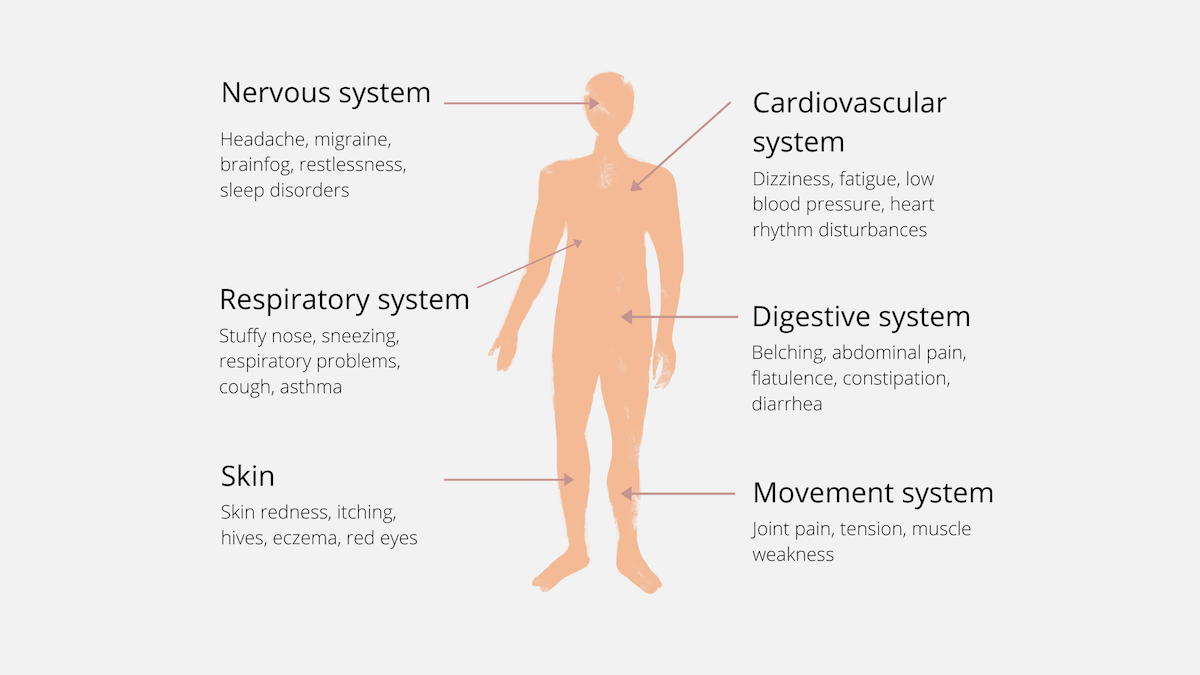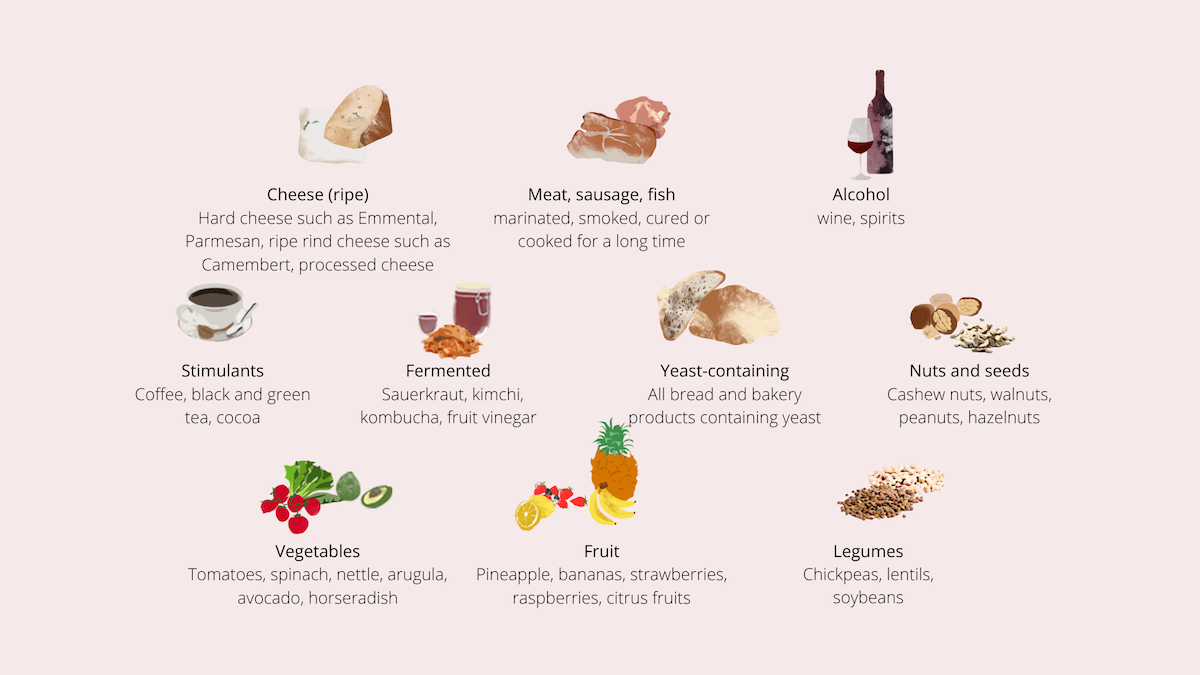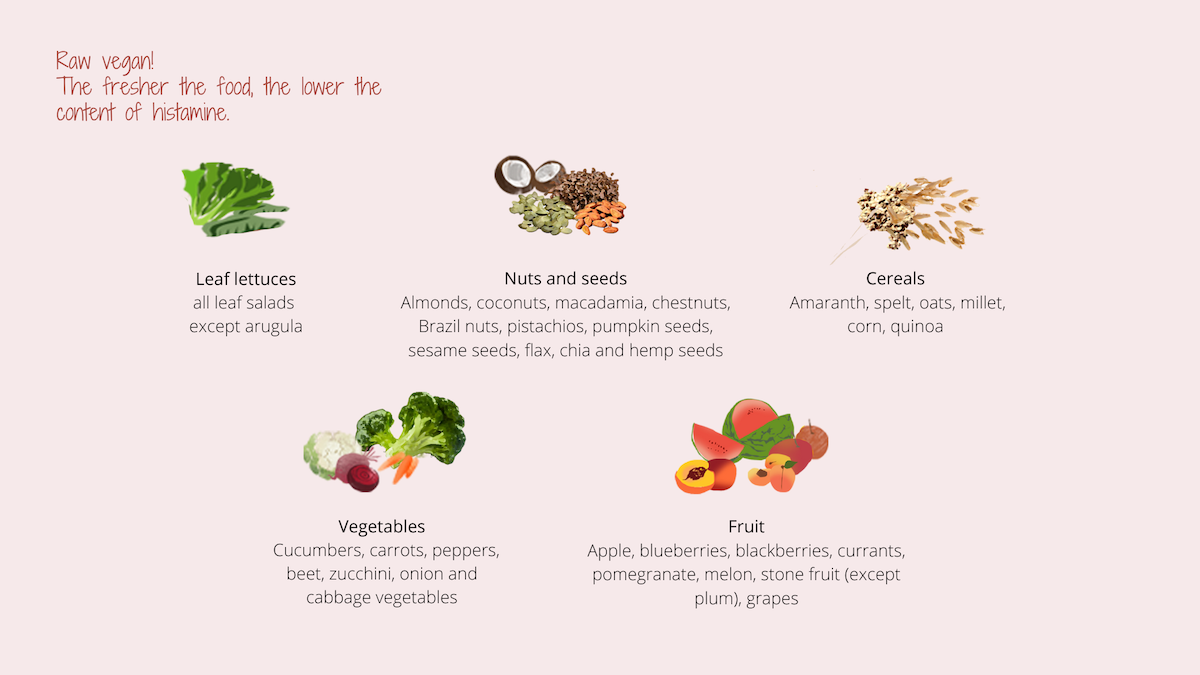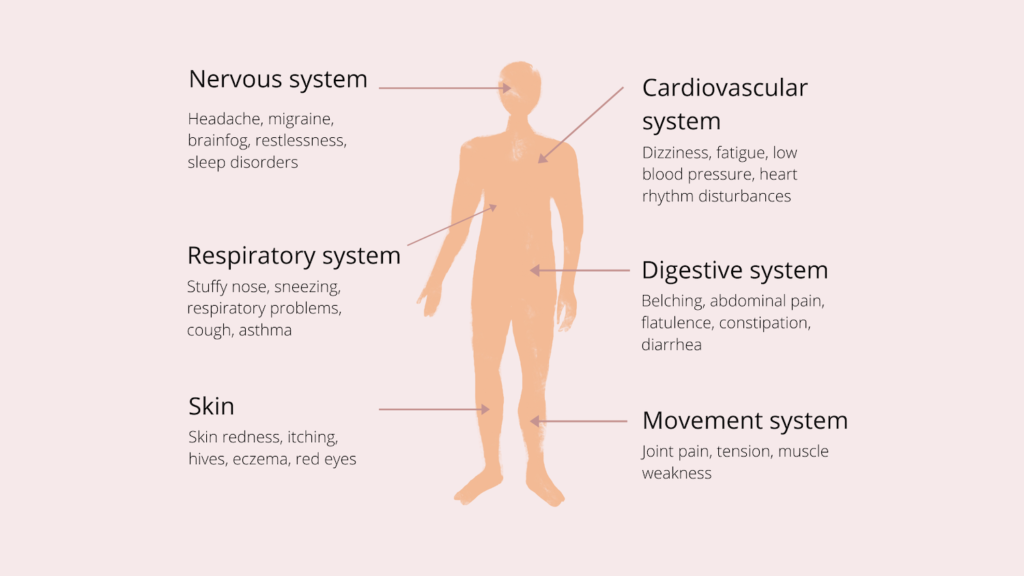Heart palpitations, red spots, digestive problems, headaches – the symptoms of histamine intolerance are both numerous and vague. For this reason, for many people it’s only discovered late or not at all. The good news is that if histamine intolerance is recognized and treated, even long-term problems can be alleviated or cured completely.
To this end, we’ll take a detailed look at its causes and treatment methods.
What is Histamine?
Biochemically, histamine (2-(4-imidazolyl)ethylamine) can be classified as a biogenic amine. Biogenic amines are formed in the metabolism of humans, animals, and plants by the conversion of amino acids. Histamine in particular is formed from the amino acid histidine.
Natural Messenger Substance That Our Body Produces Itself
In the human body, histamine regulates quite a few processes as a neurotransmitter (a messenger substance). Histamine plays a central role in allergies, and is involved in various immune system reactions, i.e. the defense against foreign substances, inflammatory reactions, and wound healing. Histamine also acts as an important messenger in the formation of gastric juice, the regulation of the water balance, and the sleep-wake rhythm.
To give some examples: when coming into physical contact with stinging nettle, histamine is released explosively through the mast cells in the skin. This reaction serves as a warning sign to the body and ultimately leads to symptoms like reddening of the skin, hives, and itching. In the case of a bee sting, histamine can lead to contraction of the bronchial tubes and shortness of breath in addition to swelling of the skin.
Histamine in Food
Histamine can also be found in food, which is how we absorb it. Histamine consumed with food is mostly broken down in the intestine, so that normally it only enters the blood in small and unproblematic amounts.
Now to be clear, there’s a distinction between foods that naturally contain larger amounts of histamine and foods in which histamine is formed over the course of microbial activity, i.e. through ripening, fermentation, or storage.
Note:
The longer a product is aged, the more histamine it contains.
What Happens in Histamine Intolerance?
In histamine intolerance, the body reacts with physical problems to increased amounts of histamine. These biogenic amines are formed from the amino acid histidine in nerve cells, mast cells, and blood platelets and are then also stored in these cells. If it’s not clear in individual cases which physical disorder is causing the histaminosis, the general term histamine intolerance is used (1).
It’s estimated that approximately 1-5% of the population experience histamine intolerance – at least 80% of whom are said to be women. Since many of these people only receive the correct diagnosis after years or even decades, it’s likely that there’s a high number of unreported cases. Histamine intolerance is much less common in children than it is in adults.
Too Much Histamine, Too Little Breakdown
In addition to consuming histamine daily through food, it’s also released from its stores in the body for a variety of reasons. In healthy people, the body breaks histamine back down so quickly that there’s no excess.
A likely factor in the development of an intolerance is an increase of the histamine level as a result of a disturbance in the breakdown proces
Two enzymes are primarily responsible for the breakdown of histamine:
- The enzyme diamine oxidase (DAO), which is produced in the intestinal mucosa
- N-methyltransferase from the liver
Note:
The following are important for the breakdown of histamines:
- Micronutrients to produce the breakdown enzymes
- A healthy intestinal mucosa
- A healthy liver
Problems: The “Histamine Barrel” Is Overflowing
The body’s histamine level can be compared to a barrel. Histamine flows into it from various sources. If the supply – whether from outside or through the body’s own release – exceeds the body’s ability to break it down, the barrel overflows. The body is literally flooded with histamine and allergy-like symptoms happen as a result. The tolerance threshold, i.e. the capacity of the barrel, can be very case-by-case, as can the extent of the symptoms.
In histamine intolerance, there’s a disproportion between histamine intake and release, with not enough breakdown happening in the body. This results in a variety of symptoms.
What Are Symptoms of Histamine Intolerance?
Since histamine is a messenger substance with a number of tasks in the body, too much of it can upset regulatory mechanisms; the result is a wide range of symptoms.
Individual: Symptoms, Severity, Timing
The combination, timing, and severity of symptoms can vary greatly from person to person. Some people experience symptoms just a few minutes after eating foods that contain histamine, while others may experience them 24 hours later. Also, different symptoms may show up at different times.
Wide Range of Symptoms
Symptoms of histamine intolerance can range from dizziness and palpitations to hives, itching, and redness of the skin, to headaches and brain fog. Since the symptoms are very unspecific and at first glance don’t appear to be directly related to each other, those affected often endure long-suffering journeys of physical problems and doctor’s visits.
Most people who react to histamine report inexplicable gastrointestinal issues. And in the meantime, it’s also possible that the cardiologist can’t explain the cardiac arrhythmia, and the dermatologist can’t find a cause for the hives and itching.
While some patients only have individual symptoms, others experience histamine intolerance with symptoms in multiple parts of the body. This is because a wide variety of cells and organs have receptors (docking sites) for histamine.
Possible Symptoms of Histamine Intolerance:

What Are the Possible Causes of Histamine Intolerance?
In most cases, the intolerance of histamine develops over the course of a person’s life. Both in theory and in practice, the exact mechanisms and causes are often unclear. So far, there are some known reasons that can lead to histamine intolerance, but not everyone who’s affected is able to pinpoint a specific cause.
Possible Causes of Histamine Intolerance:
- Genetic disposition: Studies show that intolerance often exists in multiple family members.
- Metabolic disorder HPU: Often the metabolic disorder hemopyrrollactamuria, which can be detected in the urine, is present in the body at the same time. As a result of the formation of hemopyrrollactams, people with HPU excrete zinc, manganese, and vitamin B6 daily in their urine (HPL), and thus micronutrients that are needed for the formation of the enzymes that break down histamine (among other things).
- Inflammatory bowel disease: People with Crohn’s disease and ulcerative colitis are more often affected by histamine intolerance.
- Celiac disease: This autoimmune disease, which entails a reaction to a protein known as gluten, is also associated with histamine intolerance.
- Adenomatous colon polyps: The changes in the intestine can prevent the breakdown of histamine.
- Leaky gut syndrome: Increased permeability of the intestinal barrier is thought to play a role in histamine intolerance. Finding excess histamine in the stool could be a clue.
If someone with these existing diseases or syndromes are able to get them successfully treated, then it’s likely that they’ll also be able to tolerate histamine again.
The causes of histamine intolerance are not conclusively understood and can’t always be traced. Nutrient deficiencies, metabolic disorders, or intestinal diseases, as well as leaky gut syndrome, could all be possible causes.
Are you interessted in gaining a comprehensive understanding of the health benefits of a plant-based diet? Download the curriculum for our Holistic Nutrition Coach training program.
Which Foods Contain Histamine?
FIn order to handle a histamine intolerance in the best way possible, it’s important to distinguish between three food groups in particular:
- Foods with a high histamine content
- Foods that release the histamine that already exists in the body (which are called “histamine liberators”)
- Foods rich in other biogenic amines that delay the breakdown of histamine while they also flow into the “histamine barrel”
For simplicity’s sake, these 3 groups are listed together in the following overview.
Foods Rich in Histamine

Note:
Hot spices promote histamine absorption in the gastrointestinal system, and should be used sparingly.
Basic Rules for a Low Histamine Diet
The fresher the food, the lower the histamine content. This means food should always be freshly prepared or refrigerated.
Low Histamine Foods

What to do in Case of Histamine Intolerance
If you suspect that you may have a histamine intolerance, then keeping a symptom and food journal can initially help. This may reveal that you always have symptoms after eating tomatoes, spinach, or red wine.
In nutritional therapy, a 3-step treatment of avoidance and gradual reintroduction of histamine-containing foods has proven effective:
3-Stage Therapy
- Abstinence phase: In the first phase, all histamine-rich foods should be avoided for 14 days. This is a learning process and works better and better over time. In this phase, the body has a chance to recover from the excess histamine.
- Test phase: After the strict first phase, foods that contain histamine can now be gradually integrated into the diet. It’s best to add only one type of food per day to find out which foods can be tolerated and in what quantities. This 6-8 week phase should be closely observed and any symptoms should be documented in a journal
- Long-term diet: In the subsequent long-term diet, only foods that create noticeable discomfort should be avoided; everything else is fine.
Getting to the Bottom of Causes
To get to the bottom of the possible causes of the intolerance, a test for hemopyrrollactamuria, an intestinal analysis involving a test for leaky gut syndrome (the marker zonulin provides information for this), or other tests can be considered. Thus, histamine intolerance doesn’t need to be a lifelong condition.
Season and Stress Level Have an Influence
The severity of the reaction to histamine can depend on the season, the day, and also the phase of life. For example, when pollen is flying through the air in the spring and summer, even people without any pollen allergies can have a reaction to histamine. Heat, cold, and especially stress can also stimulate the body’s own histamine secretion and cause problems as a result.
Remedy Nutrient Deficiency
The production of the enzymes diamine oxidase (DAO) and N-methyltransferase requires quite a few micronutrients. Without enough of these micronutrients, then these two enzymes can’t be adequately produced. Vitamin C, B vitamins, copper, and magnesium are particularly important for this. Nutrient deficiencies can be addressed temporarily with high-quality natural supplements, and more permanently by switching to a raw vegan diet with plenty of wild herbs and sprouts.
Intestinal Cleansing
A healthy intestinal mucosa is essential for adequate production of the histamine-degrading enzyme DAO. Some of the best methods for keeping the mucosa healthy are intestinal cleansing and eating a plant-based, high-fiber, alkaline-forming diet.
Liver Support
Nonly a strong liver can produce N-methyltransferase, the second enzyme responsible for the breakdown of histamine in our body. The intestinal cleansing is already helpful for relieving the liver, because the more the intestines are able to eliminate toxins from the body, the less the liver has to do.
The liver itself can be supported by a low-fat, raw vegan diet, as Anthony William teaches in his book “Liver Rescue”.
Conclusion:
The diagnosis of histamine intolerance doesn’t have to be a life sentence.
If you understand the causes and are open to a holistic approach, then you can also experience relief from the symptoms. Essential components are the 3-phase therapy and making a long-term switch to a nutrient-rich diet that’s both friendly to the intestine and to the liver.
Would you like to join our unique, based on nutritional sciences and practice-oriented training program for gaining a high level of health?
We are more than happy to inform you about our training program on our website!





0 Comments